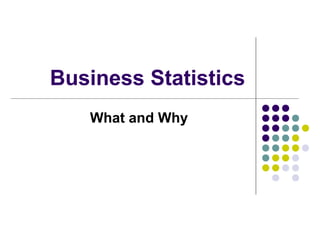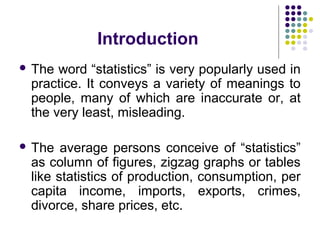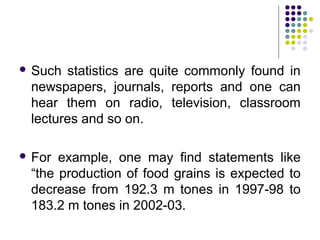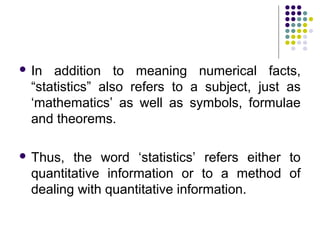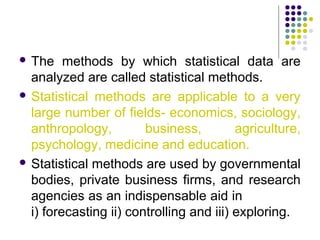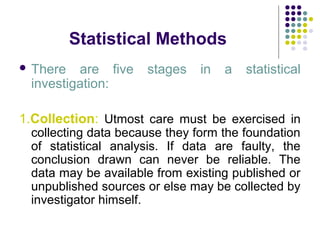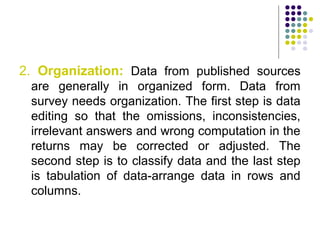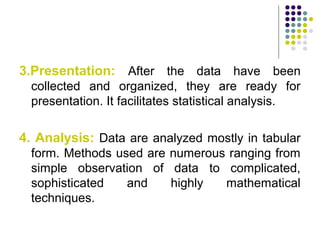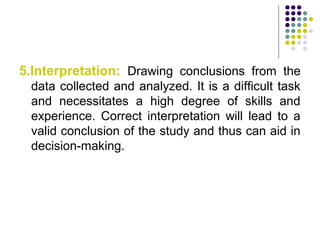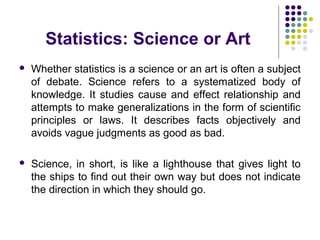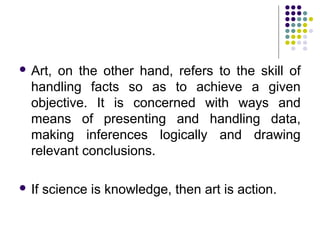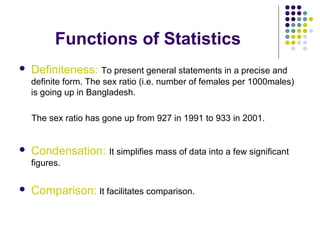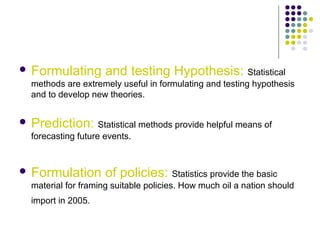Business statistics what and why
- 1. Business Statistics What and Why
- 2. Introduction The word “statistics” is very popularly used in practice. It conveys a variety of meanings to people, many of which are inaccurate or, at the very least, misleading. The average persons conceive of “statistics” as column of figures, zigzag graphs or tables like statistics of production, consumption, per capita income, imports, exports, crimes, divorce, share prices, etc.
- 3. Such statistics are quite commonly found in newspapers, journals, reports and one can hear them on radio, television, classroom lectures and so on. For example, one may find statements like “the production of food grains is expected to decrease from 192.3 m tones in 1997-98 to 183.2 m tones in 2002-03.
- 4. In addition to meaning numerical facts, “statistics” also refers to a subject, just as ‘mathematics’ as well as symbols, formulae and theorems. Thus, the word ‘statistics’ refers either to quantitative information or to a method of dealing with quantitative information.
- 5. The methods by which statistical data are analyzed are called statistical methods. Statistical methods are applicable to a very large number of fields- economics, sociology, anthropology, business, agriculture, psychology, medicine and education. Statistical methods are used by governmental bodies, private business firms, and research agencies as an indispensable aid in i) forecasting ii) controlling and iii) exploring.
- 6. Definition There have been many definitions of the term ‘statistics’- indeed scholarly articles have carefully collected together hundreds of definitions, some have defined statistics as statistical data whereas others as statistical methods. Croxton and Cowden– “Statistics may be defined as a science of collection, presentation, analysis and interpretation of numerical data.”
- 7. Statistical Methods There are five stages in a statistical investigation: 1.Collection: Utmost care must be exercised in collecting data because they form the foundation of statistical analysis. If data are faulty, the conclusion drawn can never be reliable. The data may be available from existing published or unpublished sources or else may be collected by investigator himself.
- 8. 2. Organization: Data from published sources are generally in organized form. Data from survey needs organization. The first step is data editing so that the omissions, inconsistencies, irrelevant answers and wrong computation in the returns may be corrected or adjusted. The second step is to classify data and the last step is tabulation of data-arrange data in rows and columns.
- 9. 3.Presentation: After the data have been collected and organized, they are ready for presentation. It facilitates statistical analysis. 4. Analysis: Data are analyzed mostly in tabular form. Methods used are numerous ranging from simple observation of data to complicated, sophisticated and highly mathematical techniques.
- 10. 5.Interpretation: Drawing conclusions from the data collected and analyzed. It is a difficult task and necessitates a high degree of skills and experience. Correct interpretation will lead to a valid conclusion of the study and thus can aid in decision-making.
- 11. Statistics: Science or Art Whether statistics is a science or an art is often a subject of debate. Science refers to a systematized body of knowledge. It studies cause and effect relationship and attempts to make generalizations in the form of scientific principles or laws. It describes facts objectively and avoids vague judgments as good as bad. Science, in short, is like a lighthouse that gives light to the ships to find out their own way but does not indicate the direction in which they should go.
- 12. Art, on the other hand, refers to the skill of handling facts so as to achieve a given objective. It is concerned with ways and means of presenting and handling data, making inferences logically and drawing relevant conclusions. If science is knowledge, then art is action.
- 13. Functions of Statistics Definiteness: To present general statements in a precise and definite form. The sex ratio (i.e. number of females per 1000males) is going up in Bangladesh. The sex ratio has gone up from 927 in 1991 to 933 in 2001. Condensation: It simplifies mass of data into a few significant figures. Comparison: It facilitates comparison.
- 14. Formulating and testing Hypothesis: Statistical methods are extremely useful in formulating and testing hypothesis and to develop new theories. Prediction: Statistical methods provide helpful means of forecasting future events. Formulation of policies: Statistics provide the basic material for framing suitable policies. How much oil a nation should import in 2005.
